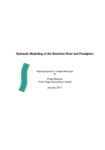Hydraulic Modelling of the Waiohine River and Floodplain
Search in document library
Purpose of the Report
To support flood risk management planning for the Waiohine River by documenting hydraulic modelling and assessing potential flood hazards.
Geographic Area Covered
The report covers the Waiohine River and its floodplain in the Wairarapa region, including tributaries such as the Ruamahanga River, Mangatarere Stream, Beef Creek, and Kaipaitangata Stream.
Summary of Key Findings
This report presents the results of hydraulic modelling undertaken to assess flood risks associated with the Waiohine River and its surrounding floodplain. The modelling was conducted using MIKE FLOOD software, which integrates one-dimensional (MIKE 11) and two-dimensional (MIKE 21) flow simulations. MIKE 11 was used to model river channels, while MIKE 21 was applied to berms and floodplain areas.
Calibration of the model was based on the July 2009 flood event, which had a peak flow of 869 m³/s. The model showed good agreement with observed debris marks, with an average error of less than 2 cm and an average absolute error of approximately 21 cm. Sensitivity tests were conducted by adjusting flow rates and channel roughness values to account for uncertainties in flow estimates and riverbed conditions.
Design scenarios were simulated for flood events with return periods ranging from 2 to 200 years, including a climate change scenario for the year 2090. The climate change scenario assumed a 2.1°C temperature rise, a 16.8% increase in rainfall intensity, and a 0.5 m sea level rise. Flood maps and peak levels were generated for each scenario, showing extensive flooding even in relatively low return periods.
A freeboard of 600 mm was added to river levels (300 mm for minor streams) to account for uncertainties and wave effects. Simulations with this adjustment showed increased floodplain inundation. The report also evaluated the effectiveness of the Saywell stopbank, demonstrating its protective role during 20-year and 100-year flood events.
Key findings include the high sensitivity of flood extents to small changes in river levels or bank heights, and challenges in calibration due to changing riverbed conditions and uncertain flow estimates. Recommendations for future improvements include expanding LiDAR coverage, conducting additional cross-section surveys, improving flow gauging at the Waiohine recorder site, and continuing debris mark recording during flood events.
Overall, the report provides a comprehensive assessment of flood hazards in the Waiohine catchment and supports informed decision-making for floodplain management and risk mitigation.
